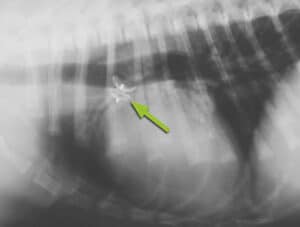Patent ductus arteriosus (PDA) is a vessel connecting the two major cardiac vessels (the aorta and the pulmonary artery) which should have closed at birth (its effects are like a ‘hole in the heart’). Uncorrected, a PDA leads to progressive heart enlargement and heart failure with lung congestion. If left untreated approximately 50% of dogs with a PDA die in the first year of life.
PDA closure involves passing catheters via the artery in the hind leg (‘keyhole’ surgery) and ‘plugging’ the PDA with an occlusive device (Amplatz Canine Duct Occluder) to stop flow through it. This device has been specifically designed for use in dogs and is the latest device currently used for PDA closure. Measuring the diameter of the duct accurately is important in selecting the correct size of device to close the defect properly. In our hands the success rate has been very high and the hospitalisation time only involves an overnight stay after the procedure and there is minimal pain compared to traditional surgery.

Closure device
There are an increasing number of embolisation devices for closure of PDAs and this continues to be an area undergoing advances in paediatric cardiology, and we are keeping abreast of these developments. Amplatz Canine Duct Occluders (ACDO) are currently the main devices used in dogs, however we still keep a stock of coils for tiny dogs and cats.

This radiograph (x-ray) shows an angiogram, which appears white to highlight the blood vessel (arrowed) to test the effectiveness and positioning of the ACDO before being released from the delivery catheter. There is no contrast (‘dye’) escaping past the ACDO which indicates that it is in a good position and providing complete closure.

Once the above test has confirmed the ACDO (arrowed) is in a good position, it is then released from the delivery catheter.
Before recommending PDA occlusion, a thorough ultrasound scan by our cardiologist (and sometimes chest x-rays) is necessary to check for signs of heart enlargement or congestion, as well as assessing to what degree heart function is reduced and to measure the size of the PDA to select the size of occluder required. Also to double check for any other concurrent defects. Closure of the PDA by a catheter-based technique is a successful and worthwhile procedure. The prognosis is excellent with a normal life expectancy, when there is no heart enlargement or evidence of congestive failure. However if there is already heart enlargement or lung congestion then a return to normal heart function is not always seen and whilst heart failure is often slowed, in some badly affected dogs it does still progress.
A follow-up scan by a cardiologist 6 to 12 months following surgery is important. This is to check for the presence of residual flow, assess heart size and function, and ensure that heart strength is good.
If you have any queries or concerns, please do not hesitate to contact us.
Arranging a referral for your pet
If you would like to refer your pet to see one of our Specialists please visit our Arranging a Referral page.